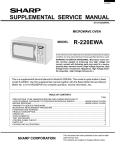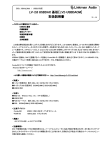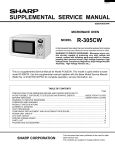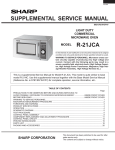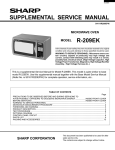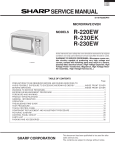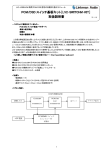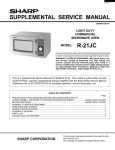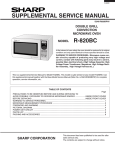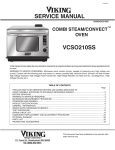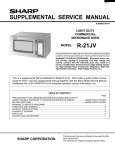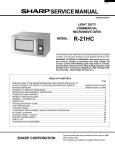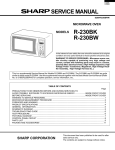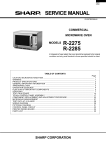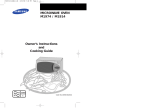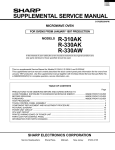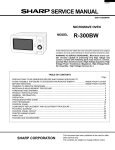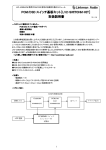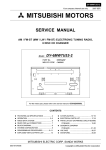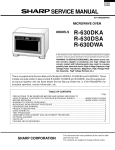Download R-200BK R-200BW SERVICE MANUAL
Transcript
R-200BK R-200BW SERVICE MANUAL S1802R200BPW/ MICROWAVE OVEN MODELS BAKED POTAT COOK 1 medium O FRESH VEGETABLES COOK 2 cups 4 5min. 6 8min. POPCORN POP 3.5 oz. bag 3 4min. R-200BK R-200BW Light Up Dial 2 40 1 3 4 5 20 0 10 15 14 13 12 11 6 7 8 9 In the interest of user-safety the oven should be restored to its original condition and only parts identical to those specified should be used. DINNER PLATE REHEAT SOUP REHEAT 1 cup ROLL/MUFFIN REHEAT 1 medium 3 4min. 6 8min. 20sec. DEFROST Check chart in Operation Manual WARNING TO SERVICE PERSONNEL: Microwave ovens contain circuitry capable of producing very high voltage and current, contact with following parts may result in a severe, possibly fatal, electrical shock. (High Voltage Capacitor, High Voltage Power Transformer, Magnetron, High Voltage Rectifier Assembly, High Voltage Harness etc..) TABLE OF CONTENTS Page PRECAUTIONS TO BE OBSERVED BEFORE AND DURING SERVICING TO AVOID POSSIBLE EXPOSURE TO EXCESSIVE MICROWAVE ENERGY ................... INSIDE FRONT COVER BEFORE SERVICING ...................................................................................................... INSIDE FRONT COVER WARNING TO SERVICE PERSONNEL ................................................................................................................ 1 MICROWAVE MEASUREMENT PROCEDURE ................................................................................................... 2 FOREWORD AND WARNING ............................................................................................................................... 3 PRODUCT SPECIFICATIONS .............................................................................................................................. 4 GENERAL INFORMATION ................................................................................................................................... 4 OPERATION .......................................................................................................................................................... 6 TROUBLESHOOTING GUIDE .............................................................................................................................. 9 TEST PROCEDURE ............................................................................................................................................ 10 TOUCH CONTROL PANEL ................................................................................................................................. 16 COMPONENT REPLACEMENT AND ADJUSTMENT PROCEDURE ................................................................ 20 PICTORIAL DIAGRAM ........................................................................................................................................ 26 CONTROL PANEL CIRCUIT ............................................................................................................................... 27 PRINTED WIRING BOARD ................................................................................................................................. 28 PARTS LIST ........................................................................................................................................................ 29 PACKING AND ACCESSORIES ......................................................................................................................... 31 SHARP CORPORATION This document has been published to be used for after sales service only. The contents are subject to change without notice. R-200BK R-200BW PRECAUTIONS TO BE OBSERVED BEFORE AND DURING SERVICING TO AVOID POSSIBLE EXPOSURE TO EXCESSIVE MICROWAVE ENERGY (a) Do not operate or allow the oven to be operated with the door open. (b) Make the following safety checks on all ovens to be serviced before activating the magnetron or other microwave source, and make repairs as necessary: (1) interlock operation, (2) proper door closing, (3) seal and sealing surfaces (arcing, wear, and other damage), (4) damage to or loosening of hinges and latches, (5) evidence of dropping or abuse. (c) Before turning on microwave power for any service test or inspection within the microwave generating compartments, check the magnetron, wave guide or transmission line, and cavity for proper alignment, integrity, and connections. (d) Any defective or misadjusted components in the interlock, monitor, door seal, and microwave generation and transmission systems shall be repaired, replaced, or adjusted by procedures described in this manual before the oven is released to the owner. (e) A microwave leakage check to verify compliance with the Federal Performance Standard should be performed on each oven prior to releasing oven to the owner. BEFORE SERVICING Before servicing an operative unit, perform a microwave emission check as per the Microwave Measurement Procedure outlined in this service manual. If microwave emissions level is in excess of the specified limit, contact SHARP ELECTRONICS CORPORATION immediately @1-800-237-4277. If the unit operates with the door open, service person should 1) tell the user not to operate the oven and 2) contact SHARP ELECTRONICS CORPORATION and Food and Drug Administration's Center for Devices and Radiological Health immediately. Service personnel should inform SHARP ELECTRONICS CORPORATION of any certified unit found with emissions in excess of 4mW/cm2. The owner of the unit should be instructed not to use the unit until the oven has been brought into compliance. R-200BK R-200BW WARNING TO SERVICE PERSONNEL Microwave ovens contain circuitry capable of producing very high voltage and current, contact with following parts may result in a severe, possibly fatal, electrical shock. (Example) High Voltage Capacitor, High Voltage Power Transformer, Magnetron, High Voltage Rectifier Assembly, High Voltage Harness etc.. Read the Service Manual carefully and follow all instructions. Don't Touch ! Danger High Voltage When the testing is completed, 1. Disconnect the power supply cord, and then remove outer case. 2. Open the door and block it open. 3. Discharge high voltage capacitor. 4. Reconnect the leads to the primary of the power transformer. 5. Reinstall the outer case (cabinet). 6. Reconnect the power supply cord after the outer case is installed. 7. Run the oven and check all function. Before Servicing 1. Disconnect the power supply cord remove outer case. 2. Open the door and block it open. 3. Discharge high voltage capacitor. , and then WARNING:RISK OF ELECTRIC SHOCK. DISCHARGE THE HIGH-VOLTAGE CAPACITOR BEFORE SERVICING. The high-voltage capacitor remains charged about 60 seconds after the oven has been switched off. Wait for 60 seconds and then short-circuit the connection of the highvoltage capacitor (that is the connecting lead of the highvoltage rectifier) against the chassis with the use of an insulated screwdriver. After repairing 1. Reconnect all leads removed from components during testing. 2. Reinstall the outer case (cabinet). 3. Reconnect the power supply cord after the outer case is installed. 4. Run the oven and check all functions. Wherever troubleshooting is performed the power supply must be disconnected. It may in, some cases, be necessary to connect the power supply after the outer case has been removed, in this event, 1. Disconnect the power supply cord, and then remove outer case. 2. Open the door and block it open. 3. Discharge high voltage capacitor. 4. Disconnect the leads to the primary of the power transformer. 5. Ensure that the leads remain isolated from other components and oven chassis by using insulation tape. 6. After that procedure, reconnect the power supply cord. Microwave ovens should not be run empty. To test for the presence of microwave energy within a cavity, place a cup of cold water on the oven turntable, close the door and set the power to HIGH and set the microwave timer for two (2) minutes. When the two minutes has elapsed (timer at zero) carefully check that the water is now hot. If the water remains cold carry out Before Servicing procedure and reexamine the connections to the component being tested. When all service work is completed and the oven is fully assembled, the microwave power output should be checked and microwave leakage test should be carried out. 1 R-200BK R-200BW MICROWAVE MEASUREMENT PROCEDURE A. Requirements: 1) Microwave leakage limit (Power density limit): The power density of microwave radiation emitted by a microwave oven should not exceed 1mW/cm2 at any point 5cm or more from the external surface of the oven, measured prior to acquisition by a purchaser, and thereafter (through the useful life of the oven), 5 mW/cm2 at any point 5cm or more from the external surface of the oven. 2) Safety interlock switches Primary interlock relay and door sensing switch shall prevent microwave radiation emission in excess of the requirement as above mentioned, secondary interlock switch shall prevent microwave radiation emission in excess of 5 mW/cm2 at any point 5cm or more from the external surface of the oven. B. Preparation for testing: Before beginning the actual measurement of leakage, proceed as follows: 1) Make sure that the actual instrument is operating normally as specified in its instruction booklet. Important: Survey instruments that comply with the requirement for instrumentation as prescribed by the performance standard for microwave ovens, 21 CFR 1030.10(c)(3)(i), must be used for testing. 2) Place the oven tray in the oven cavity. 3) Place the load of 275±15 ml (9.8 oz) of tap water initially at 20±5˚C (68˚F) in the center of the oven cavity. The water container shall be a low form of 600 ml (20 oz) beaker with an inside diameter of approx. 8.5 cm (3-1/2 in.) and made of an electrically nonconductive material such as glass or plastic. The placing of this standard load in the oven is important not only to protect the oven, but also to insure that any leakage is measured accurately. 4) Set the cooking control on Full Power Cooking Mode 5) Close the door and select a cook cycle of several minutes. If the water begins to boil before the survey is completed, replace it with 275 ml of cool water. C. Leakage test: Closed-door leakage test (microwave measurement) 1) Grasp the probe of the survey instrument and hold it perpendicular to the gap between the door and the body of the oven. 2) Move the probe slowly, not faster than 1 in./sec. (2.5 cm/sec.) along the gap, watching for the maximum indication on the meter. 3) Check for leakage at the door screen, sheet metal seams and other accessible positions where the continuity of the metal has been breached (eg., around the switches, indicator, and vents). While testing for leakage around the door pull the door away from the front of the oven as far as is permitted by the closed latch assembly. 4) Measure carefully at the point of highest leakage and make sure that the highest leakage is no greater than 4mW/cm2, and that the secondary interlock switch does turn the oven OFF before any door movement. NOTE: After servicing, record data on service invoice and microwave leakage report. 2 R-200BK R-200BW SERVICE MANUAL PRODUCT DESCRIPTION MICROWAVE OVEN R-200BK/ R-200BW GENERAL INFORMATION FOREWORD This Manual has been prepared to provide Sharp Electronics Corp. Service Personnel with Operation and Service Information for the SHARP MICROWAVE OVEN, R-200BK, R-200BW. OPERATION It is recommended that service personnel carefully study the entire text of this manual so that they will be qualified to render satisfactory customer service. TROUBLESHOOTING GUIDE AND TEST PROCEDURE Check the interlock switches and the door seal carefully. Special attention should be given to avoid electrical shock and microwave radiation hazard. TOUCH CONTROL PANEL WARNING Never operate the oven until the following points are ensured. (A) The door is tightly closed. (B) The door brackets and hinges are not defective. (C) The door packing is not damaged. (D) The door is not deformed or warped. (E) There is not any other visible damage with the oven. COMPONENT REPLACEMENT AND ADJUSTMENT PROCEDURE WIRING DIAGRAM Servicing and repair work must be carried out only by trained service personnel. DANGER Certain initial parts are intentionally not grounded and present a risk of electrical shock only during servicing. Service personnel - Do not contact the following parts while the appliance is energized; High Voltage Capacitor, Power Transformer, Magnetron, High Voltage Rectifier Assembly, High Voltage Harness; If provided, Vent Hood, Fan assembly, Cooling Fan Motor. All the parts marked “*” on parts list are used at voltages more than 250V. Removal of the outer wrap gives access to voltage above 250V. All the parts marked “∆” on parts list may cause undue microwave exposure, by themselves, or when they are damaged, loosened or removed. SHARP ELECTRONICS CORPORATION SHARP PLAZA, MAHWAH, NEW JERSEY 07430-2135 3 PARTS LIST R-200BK R-200BW PRODUCT DESCRIPTION SPECIFICATIONS ITEM Power Requirements Power Consumption Power Output Case Dimensions Cooking Cavity Dimensions (0.7 Cubic feet) Control Complement Oven Cavity Light Safety Standard DESCRIPTION 120 Volts 60 Hertz Single phase, 3 wire grounded 1030W / Approx. 9.0 Amperes 600 W nominal of RF microwave energy (IEC 705 Test procedure) Operating frequency 2450 MHz Width 18-1/8" Height 11-3/8" Depth 14-5/8" Width 12-3/8" Height 7-7/8" Depth 12-5/8" Light up dial timer (15 minutes) No cooking control Yes UL Listed. FCC Authorized DHHS RUles, CFR, Title 21, Chapter 1, Subchapter J GENERAL INFORMATION GROUNDING INSTRUCTIONS This oven is equipped with a three prong grounding plug. It must be plugged into a wall receptacle that is properly installed and grounded in accordance with the National Electrical Code and local codes and ordinances. In the event of an electrical short circuit, grounding reduces the risk of electric shock by providing an escape wire for the electric current. WARNING: Improper use of the grounding plug can result in a risk of electric shock. Electrical Requirements The electrical requirements are a 115 -120 volt 60 Hz, AC only, 15 or 20 amp. fused electrical supply. It is recommended that a separate circuit serving only this appliance be provided. When installing this appliance, observe all applicable codes and ordinances. A short power-supply cord is provided to reduce risks of becoming entangled in or tripping over a longer cord. Where a two-pronged wall-receptacle is encountered, it is the personal responsibility and obligation of the customer to contact a qualified electrician and have it replaced with a properly grounded three-pronged wall receptacle or have a grounding adapter properly grounded and polarized. If the extension cord must be used, it should be a 3-wire, 15 amp. or higher rated cord. Do not drape over a countertop or table where it can be pulled on by children or tripped over accidentally. CAUTION: DO NOT UNDER ANY CIRCUMSTANCES CUT OR REMOVE THE ROUND GROUNDING PRONG FROM THIS PLUG. Grounded 3-Pronged Plug Receptacle Box Grounding Pin 3-Pronged Receptacle 4 R-200BK R-200BW OVEN DIAGRAM 3 1. Oven door with see-through window 2. Safety door latches. 3. Door hinges 4. Door seals and sealing surfaces 5. Turntable motor shaft 6. Removable turntable support 7. Removable turntable 8. Ventilation openings. (Rear) 9. Oven lamp. 10. Wave guide cover. 11. Power supply cord 9 8 10 7 11 6 2 1 5 4 CONTROL PANEL BAKED POTATO COOK 1 medium FRESH VEGETABLES COOK 2 cups POPCORN 4 5min. 6 8min. 3 4min. POP 3.5 oz. bag t Up Dial Ligh 2 40 3 4 1 5 6 7 8 9 20 0 10 15 14 13 12 11 DINNER PLATE REHEAT SOUP REHEAT 1 cup ROLL/MUFFIN REHEAT 1 medium 3 4min. 4 5min. 20sec. DEFROST Check chart in Operation Manual 5 R-200BK R-200BW OPERATION DESCRIPTION OF OPERATING SEQUENCE box, and then into the cavity where the food is placed to be cooked. 5. Upon completion of the cooking time, the power transformer, oven lamp, etc. are turned off, and the generation of microwave energy is stopped. The oven will revert to the OFF condition. 6. When the door is opened during a cook cycle, monitor switch, door sensing switch, secondary interlock switch and primary interlock relay (RY1) are activated with the following results. The circuits to the oven lamp, turntable motor, the cooling fan motor, and the high voltage components are de-energized, and the Light Up Dial indicates the time still remaining in the cook cycle when the door was opened. 7. The monitor switch is electrically monitoring the operation of the primary interlock relay (RY1) and the secondary interlock switch and is mechanically associated with the door so that it will function in the following sequence. (1) When the door opens from the closed position, the secondary interlock switch, door sensing switch and primary interlock relay (RY1) open their contacts. Then the monitor switch contacts close. (2) When the door is closed from the open position, the monitor switch contacts open first. Then the contacts of the secondary interlock switch and door sensing switch close. If the secondary interlock switch and primary interlock relay (RY1) fail with the contacts closed when the door is opened, the closing of the monitor switch contacts will form a short circuit through the C/T fuse and primary interlock relay (RY1), causing the C/T fuse to blow. The following is a description of component functions during oven operation. OFF CONDITION Closing the door activates door sensing switch and secondary interlock switch. (In this condition, the monitor switch contacts are opened.) When oven is plugged in, 120 volts A.C. is supplied to the control unit. (Figure O-1). COOKING CONDITION When the Light Up Dial is turned, the following operations occur: 1. The contacts of the relay are closed and components connected to the relay are turned on as follows. (For details, refer to Figure O-2) RELAY RY-1 CONNECTED COMPONENTS oven lamp/turntable motor/fan motor power transformer 2. 120 volts A.C. is supplied to the primary winding of the power transformer and is converted to about 3.5 volts A.C. output on the filament winding, and approximately 2000 volts A.C. on the high voltage winding. 3. The filament winding voltage heats the magnetron filament and the H.V. winding voltage is sent to a voltage doubler circuit. 4. The microwave energy produced by the magnetron is channelled through the waveguide into the cavity feed- SCHEMATIC NOTE: CONDITION OF OVEN 1. LIGHT UP DIAL OFF. 2. DOOR CLOSED. C/T FUSE MAGNETRON THERMAL CUT-OUT COM. POWER TRANSFORMER N.O. (RY-1) PRIMARY INTERLOCK RELAY A3 OL CONTROL UNIT A1 120V AC 60 Hz A3 OVEN LAMP TTM TURNTABLE MOTOR FM MONITOR SWITCH CAPACITOR 0.72µF FAN MOTOR DOOR SENSING SWITCH RECTIFIER SECONDARY INTERLOCK SWITCH MAGNETRON Figure O-1. Oven Schematic-Off Condition 6 R-200BK R-200BW SCHEMATIC NOTE: CONDITION OF OVEN 1. DOOR CLOSED. 2. LIGHT UP DIAL ON. C/T FUSE MAGNETRON THERMAL CUT-OUT COM. POWER TRANSFORMER N.O. (RY-1) PRIMARY INTERLOCK RELAY A3 OL CONTROL UNIT A1 120V AC 60 Hz A3 TTM OVEN LAMP TURNTABLE MOTOR FM MONITOR SWITCH CAPACITOR 0.72µF FAN MOTOR DOOR SENSING SWITCH RECTIFIER SECONDARY INTERLOCK SWITCH MAGNETRON Figure O-2. Oven Schematic-Cooking Condition DESCRIPTION AND FUNCTION OF COMPONENTS DOOR OPEN MECHANISM MONITOR SWITCH The door is opened by pulling the door, refer to the Figure D-1. The monitor switch is activated (the contacts opened) by the latch head on the door while the door is closed. The switch is intended to render the oven inoperative, by means of blowing the C/T fuse, when the contacts of the primary interlock relay (RY1) and secondary interlock switch fail to open when the door is opened. Latch Heads Latch Hook Functions: 1. When the door is opened, the monitor switch contacts close (to the ON condition) due to their being normally closed. At this time the primary interlock relay (RY1) and secondary interlock switch are in the OFF condition (contacts open) due to its being normally open contact switches. 2. As the door goes to a closed position, the monitor switch contacts are first opened and then the door sensing switch and secondary interlock switch contacts close. 3. If the door is opened, and the primary interlock relay (RY1) and the secondary interlock switch contact fail to open, the C/T fuse blows simultaneously with closing of the monitor switch contacts. CAUTION: BEFORE REPLACING A BLOWN C/T FUSE, TEST THE DOOR SENSING SWITCH, PRIMARY INTERLOCK RELAY (RY1), SECONDARY INTERLOCK SWITCH AND MONITOR SWITCH FOR PROPER OPERATION. (REFER TO CHAPTER "TEST PROCEDURE"). NOTE: C/T FUSE AND MONITOR SWITCH ARE REPLACED AS AN ASSEMBLY Door Sensing Switch Door Secondary Interlock Switch Monitor Switch Figure D-1. Door Open Mechanism DOOR SENSING AND SECONDARY INTERLOCK SWITCHES The secondary interlock switch is mounted in the lower position of the latch hook and the door sensing switch in the primary interlock system is mounted in the upper position of the latch hook. They are activated by the latch heads on the door. When the door is opened, the switches interrupt the power to all high voltage components. A cook cycle cannot take place until the door is firmly closed thereby activating both interlock switches. The primary interlock system consists of the door sensing switch and primary interlock relay located on the control circuit board. 7 R-200BK R-200BW TURNTABLE MOTOR However, when abnormally high temperatures are reached within the magnetron, the thermal cut-out will open at 257˚F (125˚C), causing the oven to shut down. The turntable motor rotates the turntable located on the bottom of the oven cavity, so that the food on the turntable is cooked evenly. The turntable may turn in either direction. C/T FUSE 1. The C/T fuse blows when the contacts (COM-NO) of the primary interlock relay (RY2) and secondary interlock switch remain closed with the oven door open and when the monitor switch closes. 2. If the wire harness or electrical components are shortcircuited, this C/T fuse blows to prevent an electric shock or fire hazard. 3. The C/T fuse, located on the top of the oven cavity, is designed to prevent damage to the oven by fire. If the food load is overcooked, by either error in cook time or defect in the timer, the C/T fuse will open. Under normal operation, the C/T fuse remains closed. However, when abnormally high temperatures are reached within the oven cavity, the C/T fuse will open at 248˚F (120˚C), causing the oven to shut down or when the electric currents beyond 13A flow, the C/T fuse will open. COOLING FAN MOTOR The cooling fan motor drives a blade which draws external cool air. This cool air is directed through the air vanes surrounding the magnetron and cools the magnetron. This air is channelled through the oven cavity to remove steam and vapours given off from the heating foods. It is then exhausted through the exhausting air vents at the oven cavity. MAGNETRON THERMAL CUT-OUT The thermal cut-out located on the top of the oven cavity is designed to prevent damage to the magnetron if an over heated condition develops in the tube due to cooling fan failure, obstructed air guide, dirty or blocked air intake, etc. Under normal operation, the thermal cut-out remains closed. TROUBLESHOOTING GUIDE Never touch any part in the circuit with your hand or an uninsulated tool while the power supply is connected. When troubleshooting the microwave oven, it is helpful to follow the Sequence of Operation in performing the checks. Many of the possible causes of trouble will require that a specific test be performed. These tests are given a procedure letter which will be found in the "Test Procedure "section. IMPORTANT: If the oven becomes inoperative because of a blown C/T fuse, check the monitor switch, primary interlock relay (RY1), door sensing switch and secondary interlock switch before replacing the C/T fuse. If C/T fuse is replaced, the monitor switch must also be replaced. Use part FFS-BA020WRK0 as an assembly. IMPORTANT: Wherever troubleshooting is performed with the power supply cord disconnected. It may in, some cases, be necessary to connect the power supply cord after the outer case has been removed, in this event, 1. Disconnect the power supply cord, and then remove outer case. 2. Open the door and block it open. 3. Discharge high voltage capacitor. 4. Disconnect the leads to the primary of the power transformer. 5. Ensure that the leads remain isolated from other components and oven chassis by using insulation tape. 6. After that procedure, reconnect the power supply cord. When the testing is completed, 1. Disconnect the power supply cord, and then remove outer case. 2. Open the door and block it open. 3. Discharge high voltage capacitor. 4. Reconnect the leads to the primary of the power transformer. 5. Reinstall the outer case (cabinet). 6. Reconnect the power supply cord after the outer case is installed. 7. Run the oven and check all function. 8 R-200BK R-200BW CK = Check / RE = Replace FOIL PATTERN ON PWB. DIRTY OVEN CAVITY LOW VOLTAGE WRONG OPERATION CONTROL UNIT OR RELAY TURNTABLE MOTOR COOLING FAN MOTOR OVEN LAMP OR SOCKET C/T FUSE MONITOR SWITCH F G H RE RE CK I/J CK CK CK K SECONDARY INTERLOCK SWITCH PRIMARY INTERLOCK SYSTEM MAGNETRON THERMAL CUT-OUT HIGH VOLTAGE CAPACITOR C D E F H.V. RECTIFIER ASSEMBLY POWER TRANSFORMER PROBLEM CONDITION MAGNETRON SHORT IN POWER CORD POSSIBLE CAUSE AND DEFECTIVE PARTS SHORT OR OPEN WIRING RE CK A B TEST PROCEDURE Home fuse blows when power cord is plugged into wall receptacle. OFF CONDITION C/T fuse blows when power cord is plugged into wall receptacle. C/T fuse blows when the door is opened. Fan motor does not operate. (All other electric components function.) Oven lamp does not light at all. (All other electric components function.) Turntable motor does not operate. (All other electric components function.) COOKING CONDITION Oven does not go into cook cycle when Light Up Dial is turned Oven seems to be operating but little or no heat is produced in oven load. (Food incompletely cooked or not cooked at all at end of cook cycle.) Oven goes into a cook cycle but extremely uneven heating is produced in oven load (food). Oven lamp, turntable motor and fan motor do not operate. TEST PROCEDURES PROCEDURE LETTER A COMPONENT TEST MAGNETRON ASSEMBLY TEST 1. 2. 3. 4. 5. 6. 7. 8. 9. Disconnect the power supply cord, and then remove outer case. Open the door and block it open. Discharge high voltage capacitor. To test for an open filament, isolate the magnetron from the high voltage circuit. A continuity check across the magnetron filament leads should indicate less than 1 ohm. To test for a shorted magnetron, connect the ohmmeter leads between the magnetron filament leads and chassis ground. This test should indicate an infinite resistance. If there is little or no resistance the magnetron is grounded and must be replaced. Reconnect all leads removed from components during testing. Reinstall the outer case (cabinet). Reconnect the power supply cord after the outer case is installed. Run the oven and check all functions. MICROWAVE OUTPUT POWER The following test procedure should be carried out with the microwave oven in a fully assembled condition (outer case fitted). 9 R-200BK R-200BW TEST PROCEDURES PROCEDURE LETTER COMPONENT TEST HIGH VOLTAGES ARE PRESENT DURING THE COOK CYCLE, SO EXTREME CAUTION SHOULD BE OBSERVED. Power output of the magnetron can be measured by performing a water temperature rise test. This test should only be used if above tests do not indicate a faulty magnetron and there is no defect in the following components or wiring: silicon rectifier, high voltage capacitor and power transformer. This test will require a 16 ounce (453cc) measuring cup and an accurate mercury thermometer or thermocouple type temperature tester. For accurate results, the following procedure must be followed carefully: 1. Fill the measuring cup with 16 oz. (453cc) of tap water and measure the temperature of the water with a thermometer or thermocouple temperature tester. Stir the thermometer or thermocouple through the water until the temperature stabilizes. Record the temperature of the water. 2. Place the cup of water in the oven. Operate oven at POWER 10(HIGH) selecting more than 60 seconds cook time. Allow the water to heat for 60 seconds, measuring with a stop watch, second hand of a watch or the digital read-out countdown. 3. Remove the cup from the oven and again measure the temperature, making sure to stir the thermometer or thermocouple through the water until the maximum temperature is recorded. 4. Subtract the cold water temperature from the hot water temperature. The normal result should be 15 to 28˚F(8.3 to 15.6˚C) rise in temperature. If the water temperatures are accurately measured and tested for the required time period the test results will indicate if the magnetron tube has low power output (low rise in water temperature) which would extend cooking time or high power output (high rise in water temperature) which would reduce cooking time. Because cooking time can be adjusted to compensate for power output, the magnetron tube assembly should be replaced only if the water temperature rise test indicates a power output well beyond the normal limits. The test is only accurate if the power supply line voltage is 120 volts and the oven cavity is clean. B POWER TRANSFORMER TEST 1. 2. 3. 4. 5. 6. 7. 8. Disconnect the power supply cord, and then remove outer case. Open the door and block it open. Discharge high voltage capacitor. Disconnect the primary input terminals and measure the resistance of the transformer with an ohmmeter. Check for continuity of the coils with an ohmmeter. On the R x 1 scale, the resistance of the primary coil should be less than 1 ohm and the resistance of the high voltage coil should be approximately 164 ohms; the resistance of the filament coil should be less than 1 ohm. Reconnect all leads removed from components during testing. Reinstall the outer case (cabinet). Reconnect the power supply cord after the outer case is installed. Run the oven and check all functions. (HIGH VOLTAGES ARE PRESENT AT THE HIGH VOLTAGE TERMINAL, SO DO NOT ATTEMPT TO MEASURE THE FILAMENT AND HIGH VOLTAGE.) C HIGH VOLTAGE RECTIFIER TEST 1. 2. 3. 4. Disconnect the power supply cord, and then remove outer case. Open the door and block it open. Discharge high voltage capacitor. Isolate the rectifier from the circuit. Using the highest ohm scale of the meter, read the resistance across the terminals and observe, reverse the leads to the rectifier terminals and observe meter reading. If a short is indicated in both directions, or if an infinite resistance is read in both directions, the rectifier is probably defective and should be replaced. 5. Reconnect all leads removed from components during testing. 6. Reinstall the outer case (cabinet). 7. Reconnect the power supply cord after the outer case is installed. 10 R-200BK R-200BW TEST PROCEDURES PROCEDURE LETTER COMPONENT TEST 8. Run the oven and check all functions. NOTE: Be sure to use an ohmmeter that will supply a forward bias voltage of more than 6.3 volts. D HIGH VOLTAGE CAPACITOR TEST 1. 2. 3. 4. 5. 6. 7. 8. E Disconnect the power supply cord, and then remove outer case. Open the door and block it open. Discharge high voltage capacitor. If the capacitor is open, no high voltage will be available to the magnetron. Disconnect input leads and check for short or open between the terminals using an ohmmeter. Checking with a high ohm scale, if the high voltage capacitor is normal, the meter will indicate continuity for a short time and should indicate an open circuit once the capacitor is charged. If the above is not the case, check the capacitor with an ohmmeter to see if it is shorted between either of the terminals and case. If it is shorted, replace the capacitor. Reconnect all leads removed from components during testing. Reinstall the outer case (cabinet). Reconnect the power supply cord after the outer case is installed. Run the oven and check all functions. MAGNETRON THERMAL CUT-OUT TEST 1. 2. 3. 4. Disconnect the power supply cord, and then remove outer case. Open the door and block it open. Discharge high voltage capacitor. A continuity check across the thermal cut-out terminals should indicate a closed circuit. If the temperature of the magnetron reaches approximately 257˚F(125˚C), the thermal cut-out opens. An open thermal cut-out indicates overheating of the magnetron. Check for restricted air flow to the magnetron, especially the cooling fan air guide. 5. Reconnect all leads removed from components during testing. 6. Reinstall the outer case (cabinet). 7. Reconnect the power supply cord after the outer case is installed. 8. Run the oven and check all functions. CAUTION: IF THE THERMAL CUT-OUT INDICATES AN OPEN CIRCUIT AT ROOM TEMPERATURE, REPLACE THERMAL CUT-OUT. F SECONDARY INTERLOCK SWITCH TEST 1. 2. 3. 4. 5. 6. 7. 8. Disconnect the power supply cord, and then remove outer case. Open the door and block it open. Discharge high voltage capacitor. Isolate the switch and connect the ohmmeter to the common (COM.) and normally open (NO) terminal of the switch. The meter should indicate an open circuit with the door open and a closed circuit with the door closed. If improper operation is indicated, replace the secondary interlock switch. Reconnect all leads removed from components during testing. Reinstall the outer case (cabinet). Reconnect the power supply cord after the outer case is installed. Run the oven and check all functions. PRIMARY INTERLOCK SYSTEM TEST DOOR SENSING SWITCH 1. Disconnect the power supply cord, and then remove outer case. 2. Open the door and block it open. 3. Discharge high voltage capacitor. 4. Isolate the switch and connect the ohmmeter to the common (COM.) and normally open (NO) terminal of the switch. The meter should indicate an open circuit with the door open and a closed circuit with 11 R-200BK R-200BW TEST PROCEDURES PROCEDURE LETTER COMPONENT TEST 5. 6. 7. 8. the door closed. If improper operation is indicated, replace the door sensing switch. Reconnect all leads removed from components during testing. Reinstall the outer case (cabinet). Reconnect the power supply cord after the outer case is installed. Run the oven and check all functions. PRIMARY INTERLOCK RELAY (RY1) 1. Disconnect the power supply cord, and then remove outer case. 2. Open the door and block it open. 3. Discharge high voltage capacitor. 4. Disconnect two (2) wire leads from the male tab terminals of the Primary Interlock Relay. Check the state of the relay contacts using a ohmmeter. The relay contacts should be open. If the relay contacts are closed, replace the circuit board entirely or the relay itself. 5. Reconnect all leads removed from components during testing. 6. Reinstall the outer case (cabinet). 7. Reconnect the power supply cord after the outer case is installed. 8. Run the oven and check all functions. G MONITOR SWITCH TEST 1. 2. 3. 4. 5. 6. 7. 8. Disconnect the power supply cord, and then remove outer case. Open the door and block it open. Discharge high voltage capacitor. Before performing this test, make sure that the secondary interlock switch and the primary interlock relay are operating properly, according to the above Switch Test Procedure. Disconnect the wire lead from the monitor switch (COM) terminal. Check the monitor switch operation by using the ohmmeter as follows. When the door is open, the meter should indicate a closed circuit. When the monitor switch actuator is pushed by a screw driver through the lower latch hole on the front plate of the oven cavity with the door opened (in this condition the plunger of the monitor switch is pushed in), the meter should indicate an open circuit. If improper operation is indicated, the switch may be defective. After testing the monitor switch, reconnect the wire lead to the monitor switch (COM) terminal and check the continuity of the monitor circuit. Reconnect all leads removed from components during testing. Reinstall the outer case (cabinet). Reconnect the power supply cord after the outer case is installed. Run the oven and check all functions. SCREW DRIVER MONITOR SWITCH OHMMETER H BLOWN C/T FUSE TEST 1. 2. 3. 4. Disconnect the power supply cord, and then remove outer case. Open the door and block it open. Discharge high voltage capacitor. If the C/T fuse is blown when the door is opened, check the primary interlock relay, secondary interlock switch and monitor switch according to the "TEST PROCEDURE" for those switches before replacing the blown C/T fuse. CAUTION: BEFORE REPLACING A BLOWN C/T FUSE, TEST THE PRIMARY INTERLOCK RELAY, SECONDARY INTERLOCK SWITCH, DOOR SENSING SWITCH AND MONITOR SWITCH FOR PROPER OPERATION. 12 R-200BK R-200BW TEST PROCEDURES PROCEDURE LETTER COMPONENT TEST If the C/T fuse is blown by improper switch operation, the C/T fuse and monitor switch must be replaced with "C/T fuse and monitor switch assembly" part number FFS-BA020WRK0, even if the monitor switch operates normally. The C/T fuse and monitor switch assembly is comprised of a 13 ampere fuse and switch. A continuity check across the C/T fuse terminals should indicate a closed circuit unless the temperature of the C/T fuse reaches approximately 248˚F(120˚C). An open C/T fuse indicates the oven overheated, Replace the oven C/T fuse and check the inside of the oven cavity, the proper setting of cooking time and the proper operation of control unit. Also check for proper air flow through the ovens venting system. Especially check the cooling fan for proper operation and the air guide for restriction. CAUTION: IF THE C/T FUSE INDICATES AN OPEN CIRCUIT AT ROOM TEMPERATURE, REPLACE THE C/T FUSE. 5. Reconnect all leads removed from components during testing. 6. Reinstall the outer case (cabinet). 7. Reconnect the power supply cord after the outer case is installed. 8. Run the oven and check all functions. I CONTROL PANEL ASSEMBLY TEST WARNING : Do not touch the electrical parts and the printed wiring board to prevent an electric shock. Because the control unit is "TRANSLESS CIRCUIR" and many electrical parts are used at A.C. line voltage. The control panel consists of circuits including semiconductors such as LSI, ICs, etc. Therefore, unlike conventional microwave ovens, proper maintenance cannot be performed with only a voltmeter and ohmmeter. In this service manual troubleshooting by unit replacement is described according to the symptoms indicated. Before testing, 1) Disconnect the power supply cord and then remove outer case. 2) Open the door and block it open. 3) Discharge high voltage capacitor. 4) Disconnect the leads to the primary of the power transformer. 5) Ensure that these leads remain isolated from other components and oven chassis by using insulation tape. 6) After that procedure, re-connect the power supply cord. 1. Control Panel The following symptoms indicate a defective control unit. 1-1 In connection with LEDs a) At a certain LED, all or some LEDs do not light up. b) At a certain LED, brightness is low. c) Only one LED does not light up. d) All or some LEDs continue to light up. e) A certain group of LEDs do not light up. f) The LEDs flicker. 1-2 Other possible troubles caused by defective control unit. a) Buzzer does not sound or continues to sound. b) Clock is not possible. c) Cooking time can not be set. When testing is completed, 1) Disconnect the power supply cord and then remove outer case. 2) Open the door and block it open. 3) Discharge high voltage capacitor. 4) Reconnect all leads removed from components during testing. 5) Re-install the outer case (cabinet). 6) Reconnect the power supply cord after the outer case is installed. 7) Run the oven and check all function. 13 R-200BK R-200BW TEST PROCEDURES PROCEDURE LETTER J COMPONENT TEST RELAY TEST 1. 2. 3. 4. 5. Disconnect the power supply cord and then remove outer case. Open the door and block it open. Discharge high voltage capacitor. Disconnect the leads to the primary of the power transformer. Ensure that these leads remain isolated from other components and oven chassis by using insulation tape. 6. After that procedure, re-connect the power supply cord. 7. Remove the outer case and check voltage between Pin No. 5 of the 3 pin connector (A) and the common terminal of the relay RY1 on the control unit with an A.C. voltmeter. The meter should indicate 120 volts, if not check oven circuit. RY1 Relay Test These relays are operated by D.C. voltage Check voltage at the relay coil with a D.C. voltmeter during the microwave cooking operation. DC. voltage indicated ............. Defective relay. DC. voltage not indicated ........ Check diode which is connected to the relay coil. If diode is good, control unit is defective. RELAY SYMBOL RY1 8. 9. 10. 11. 12. 13. 14. K OPERATIONAL VOLTAGE CONNECTED COMPONENTS Oven lamp / Turntable motor / Cooling fan motor / Power transformer Approx. 17.0V D.C. The voltage under the condition when all LEDs light up. Disconnect the power supply cord and then remove outer case. Open the door and block it open. Discharge high voltage capacitor. Reconnect all leads removed from components during testing. Re-install the outer case (cabinet). Reconnect the power supply cord after the outer case is installed. Run the oven and check all function. FOIL PATTERN ON THE PRINTED WIRING BOARD TEST To protect the electronic circuits, this model is provided with a fine foil pattern added to the primary on the PWB, this foil pattern acts as a fuse. 1. Foil pattern check and repairs. 1) Disconnect the power supply cord and then remove outer case. 2) Open the door and block it open. 3) Discharge high voltage capacitor. 4) Follow the troubleshooting guide given below for repair. STEPS 1 2 OCCURRENCE CAUSE OR CORRECTION Only pattern at "a" is broken. Pattern at "a" and "b" are broken. *Insert jumper wire J1 and solder. *Insert the coil RCILF2003YAZZ between "c" and "d". 5) Make a visual inspection of the varistor. Check for burned damage. RY2 RY1 R11 ORG BRK c ORG RED RED ,F 14 5 a b (J1) 5 CN-A d VRS1 R-200BK R-200BW TEST PROCEDURES PROCEDURE LETTER COMPONENT TEST 6) Reconnect all leads removed from components during testing. 7) Re-install the outer case (cabinet). 8) Reconnect the power supply cord after the outer case is installed. 9) Run the oven and check all function. 2. Follow the troubleshooting guide given below, if indicator does not light up after above check and repairs are finished. 1) Disconnect the power supply cord and then remove outer case. 2) Open the door and block it open. 3) Discharge high voltage capacitor. 4) Disconnect the leads to the primary of the power transformer. 5) Ensure that these leads remain isolated from other components and oven chassis by using insulation tape. 6) After that procedure, re-connect the power supply cord. 7) Follow the troubleshooting guide given below for repair. STEPS 1 OCCURRENCE CAUSE OR CORRECTION The rated AC voltage is not present between Pin No. 5 of the 3-pin connector (A) and the common terminal of the relay RY1 Check supply voltage and oven power cord. 8) Disconnect the power supply cord and then remove outer case. 9) Open the door and block it open. 10) Discharge high voltage capacitor. 11) Reconnect all leads removed from components during testing. 12) Re-install the outer case (cabinet). 13) Reconnect the power supply cord after the outer case is installed. 14) Run the oven and check all function. 15 R-200BK R-200BW CONTROL PANEL ASSEMBLY OUTLINE OF CONTROL PANEL Control Unit Control unit consists of LSI, power source circuit, synchronizing signal circuit, ACL circuit, buzzer circuit, encoder circuit and indicator circuit. 4) ACL A circuit to generate a signals which resets the LSI to the initial state when power is supplied. 5) Buzzer Circuit The buzzer is responsive to signals from the LSI to emit audible sounds (completion sound). 1) LSI This LSI controls the encoder signal, relay driving signal for oven function, buzzer signal and LED signal. 6) Door Sensing Switch (Stop Switch) A switch to “tell” the LSI if the door is open or closed. 2) Power Source Circuit This circuit generates voltage necessary in the control unit. Symbol VC VR Voltage +5.0V +17.0V 7) Relay Circuit To drive the magnetron, fan motor, turntable motor and light the oven lamp. Application LSI(I-1) RELAY(RY1) 8) Encoder The encoder generates the pulse signal, and the pulse signal is sent to the LSI. The voltage under the condition when all LEDs light up. The voltage VR will vary according to the quantity of the LEDs which light up. 9) Indicator Circuit Indicator elements are the Light-emitting diodes (LD1LD20). This circuit consists of 4-digits and 5 segments. 3) Synchronizing Signal Circuit The power source synchronizing signal is available in order to compose a basic standard time in the clock circuit. It accompanies a very small error because it works on commercial frequency. 16 R-200BK R-200BW DESCRIPTION OF LSI LSI(IZA860DR) The I/O signal of the LSI(IZA860DR) are detailed in the following table. Pin No. Signal I/O Description 1 RST IN Auto clear terminal. Signal is input to reset the LSI to the initial state when power is applied. Temporarily set to “L” level the moment power is applied, at this time the LSI is reset. Thereafter set at “H” level. 2 INT IN Signal coming from encoder. When the encoder is turned, the contacts of encoder make pulse signals. And pulse signals are input into INT. 3 AVSS IN A/D converter power source voltage. The power source voltage to drive the A/D converter in the LSI. Connected to GND. 4 VREF IN Reference voltage input terminal. A reference voltage is applied to the A/D converter in the LSI. Connected to GND. 5 K0 IN Terminal to change functions according to the model. Signal in accordance with the model in operation is applied to set up its function. 6 K1 IN Connected to GND. 7 AVDD IN A/D converter power source voltage. The power source voltage to drive the A/D converter in the LSI. 8 NC 9 S0 OUT Digit selection signal. Signal is input to the anodes of the light-emitting diodes (LD1 - LD5). 10 S1 OUT Digit selection signal. Signal is input to the anodes of the light-emitting diodes (LD6 - LD10). 11 S2 OUT Digit selection signal. Signal is input to the anodes of the light-emitting diodes (LD11 - LD15). 12 S3 OUT Digit selection signal. Signal is input to the anodes of the light-emitting diodes (LD16 - LD20). 13-14 NC 15 D0 OUT Connected to VC. 16 D1 OUT Magnetron high-voltage circuit, oven lamp, turntable motor and fan motor 16.7 msec. driving signal(Square Waveform : 60Hz) H To turn on and off the relay (RY1). In 100% POWER operation, the signals hold “L” level during microwave cookL During cooking ing and “H” level while not cooking. 17 CNVS IN Reference voltage input terminal. A reference voltage is applied to the A/D converter in the LSI. Connected to GND. 18 VSS IN Power source voltage: -0V. The power source voltage to drive the LSI is input to VSS terminal. Connected to GND. 19 D2 OUT Segment data signal. Signal is input to the cathodes of the light-emitting diodes (LD1 ,LD6, LD11 and LD16). 20 D3 OUT Segment data signal. Signal is input to the cathodes of the light-emitting diodes (LD1-LD2, LD6-LD7, LD12, LD16 and LD17). 21 D4 OUT Segment data signal. Signal is input to the cathodes of the light-emitting diodes (LD1-LD3, LD6-LD8, LD11LD13, LD16-LD17 and LD18). No connection terminal. No connection terminal. 17 R-200BK R-200BW Pin No. 22 23-25 Signal I/O D5 OUT Segment data signal. Signal is input to the cathodes of the light-emitting diodes (LD1-LD4, LD6-LD9, LD11LD14, LD16-LD18 and LD19). D6-D7 OUT Segment data signal. Signal is input to the cathodes of all light-emitting diodes (LD1-D20). 26 NC 27 F0 Description No connection terminal. IN Input signal which communicates the door open/close information to LSI. Door closed; “L” level signal. Door opened; “H” level signal. 28 F1 OUT Connected to CNTR. 29 F2 OUT Terminal not used. 30 F3 IN 31-32 NC Signal coming from encoder. Signal similar to INT. Pulse signals are input into F3. No connection terminal. 33 XOUT OUT 34 XIN IN 35 CNTR OUT Internal clock oscillation frequency control output. Output to control oscillation input of XOUT. Internal clock oscillation frequency input setting. The internal clock frequency is set by inserting the ceramic filter oscillation circuit with respect to XIN terminal. Signal to sound buzzer. A: Completion sound. 2.0 sec. H : VC(+5V) A L : GND 36 VDD IN Power source voltage: +5.0V. The power source voltage to drive the LSI is input to VDD terminal. 18 R-200BK R-200BW SERVICING 1. Precautions for Handling Electronic Components This unit uses CMOS LSI in the integral part of the circuits. When handling these parts, the following precautions should be strictly followed. CMOS LSI have extremely high impedance at its input and output terminals. For this reason, it is easily influenced by the surrounding high voltage power source, static electricity charge in clothes, etc., and sometimes it is not fully protected by the built-in protection circuit. In order to protect CMOS LSI. 1) When storing and transporting, thoroughly wrap them in aluminium foil. Also wrap PW boards containing them in aluminium foil. 2) When soldering, ground the technician as shown in the figure and use grounded soldering iron and work table. 5) Re-connect the power supply cord after the outer case is installed. 6) Run the oven and check all function. A. On some models, the power supply cord between the touch control panel and the oven itself is so short that the two can't be separated. For those models, check and repair all the controls (sensor-related ones included) of the touch control panel while keeping it connected to the oven. B. On some models, the power supply cord between the touch control panel and the oven proper is so long enough that they may be separated from each other. For those models, therefore, it is possible to check and repair the controls of the touch control panel while keeping it apart from the oven proper; in this case you must short both ends of the door sensing switch (on PWB) of the touch control panel with a jumper, which brings about an operational state that is equivalent to the oven door being closed. As for the sensor-related controls of the touch control panel, checking them is possible if the dummy resistor(s) with resistance equal to that of the controls are used. (2) Servicing the touch control panel with power supply from an external power source: Disconnect the touch control panel completely from the oven proper, and short both ends of the door sensing switch (on PWB) of the touch control panel, which brings about an operational state that is equivalent to the oven door being closed. Connect an external power source to the power input terminal of the touch control panel, then it is possible to check and repair the controls of the touch control panel; it is also possible to check the sensorrelated controls of the touch control panel by using the dummy resistor(s). approx. 1M ohm 2. Shapes of Electronic Components Transistor 2SA1267Y 2SC1740S DTA143ES DTC143ES E CB 3. Servicing of Touch Control Panel We describe the procedures to permit servicing of the touch control panel of the microwave oven and the precautions you must take when doing so. To perform the servicing, power to the touch control panel is available either from the power line of the oven itself or from an external power source. (1) Servicing the touch control panel with power supply of the oven : CAUTION: THE HIGH VOLTAGE TRANSFORMER OF THE MICROWAVE OVEN IS STILL LIVE DURING SERVICING AND PRESENTS A HAZARD . Therefore, before checking the performance of the touch control panel, 1) Disconnect the power supply cord and then remove outer case. 2) Open the door and block it open. 3) Discharge high voltage capacitor. 4) Disconnect the leads to the primary of the power transformer. 5) Ensure that these leads remain isolated from other components and oven chassis by using insulation tape. 6) After that procedure, re-connect the power supply cord. After checking the performance of the touch control panel, 1) Disconnect the power supply cord. 2) Open the door and block it open. 3) Re-connect the leads to the primary of the power transformer. 4) Re-install the outer case (cabinet). 4. Servicing Tools Tools required to service the touch control panel assembly. 1) Soldering iron: 30W (It is recommended to use a soldering iron with a grounding terminal.) 2) Oscilloscope: Single beam, frequency range: DC 10MHz type or more advanced model. 3) Others: Hand tools 5. Other Precautions 1) Before turning on the power source of the control unit, remove the aluminium foil applied for preventing static electricity. 2) Connect the connector of the key unit to the control unit being sure that the lead wires are not twisted. 3) After aluminium foil is removed, be careful that abnormal voltage due to static electricity etc. is not applied to the input or output terminals. 4) Attach connectors, electrolytic capacitors, etc. to PWB, making sure that all connections are tight. 5) Be sure to use specified components where high precision is required. 19 R-200BK R-200BW COMPONENT REPLACEMENT AND ADJUSTMENT PROCEDURE WARNING AGAINST HIGH VOLTAGE: Microwave ovens contain circuitry capable of producing very high voltage and current, contact with following parts may result in severe, possibly fatal, electric shock. (Example) High Voltage Capacitor, Power Transformer, Magnetron, High Voltage Rectifier Assembly, High Voltage Harness etc.. WARNING: Avoid possible exposure to microwave energy. Please follow the instructions below before operating the oven. 1. Disconnect the power supply cord. 2. Visually check the door and cavity face plate for damage (dents, cracks, signs of arcing etc.). 4. The door is bent or warped. 5. There are defective parts in the door interlock system. 6. There are defective parts in the microwave generating and transmission assembly. 7. There is visible damage to the oven. Carry out any remedial work that is necessary before operating the oven. Do not operate the oven if any of the following conditions exist; 1. Door does not close firmly. 2. Door hinge, support or latch hook is damaged. 3. The door gasket or seal is damaged. Do not operate the oven: 1. Without the RF gasket (Magnetron). 2. If the wave guide or oven cavity are not intact. 3. If the door is not closed. 4. If the outer case (cabinet) is not fitted. WARNING FOR WIRING To prevent an electric shock, take the following precautions. 1. Before wiring, 1) Disconnect the power supply cord. 2) Open the door and block it open. 3) Discharge the high voltage capacitor and wait for 60 seconds. 2. Don’t let the wire leads touch to the followiong parts; 1) High voltage parts: Magnetron, High voltage transformer, High voltage capacitor and High voltage rectifier assembly. 2) Hot parts: Oven lamp, Magnetron, High voltage transformer and Oven cavity. 3) Sharp edge: Bottom plate, Oven cavity, Waveguide flange, Chassis support and other metallic plate. 4) Movable parts (to prevent a fault) Fan blade, Fan motor, Switch, Switch lever, Open button. 3. Do not catch the wire leads in the outer case cabinet. 4. Insert the positive lock connector until its pin is locked and make sure that the wire leads do not come off even if the wire leads are pulled. 5. To prevent an error function, connect the wire leads correctly, referring to the Pictorial Diagram. Please refer to ‘OVEN PARTS, CABINET PARTS, CONTROL PANAL PARTS, DOOR PARTS’, when carrying out any of the following removal procedures: OUTER CASE REMOVAL To remove the outer case, procedure as follows. 1. Disconnect the power supply cord. 2. Open the oven door and block it open. 3. Remove the two (2) screws from the lower portion of the rear cabinet using a T20H Torx type or GTXH20-100 screw driver. 4. Remove the remaining two (2) screws from rear and four (4) screws along the right and left side of outer case. 5. Slide the entire outer case back out about 1 inch (3 cm) to free it from retaining clips on the cavity face plate. 6. Lift entire outer case from the unit. Special Screw Screw Driver Type: TORX T20 H or GTXH20-100 20 R-200BK R-200BW NOTE: When replacing the outer case, the 2 special Torx screws must be reinstalled in the same locations. CAUTION: 1. DISCONNECT OVEN FROM POWER SUPPLY BEFORE REMOVING OUTER CASE. 2. DISCHARGE THE HIGH VOLTAGE CAPACITOR BEFORE TOUCHING ANY OVEN COMPONENTS OR WIRING. MAGNETRON REMOVAL 1. 2. 3. 4. 5. Disconnect the power supply cord and remove outer case. Open the oven door and block it open. Discharge high voltage capacitor. Disconnect the wire leads from magnetron. Remove the three (3) screws holding the magnetron to the waveguide. 6. Remove the magnetron from waveguide. 7. Now, the magnetron is free. CAUTION: WHEN REPLACING THE MAGNETRON, BE SURE THE R.F. GASKET IS IN PLACE AND THE MAGNETRON MOUNTING SCREWS ARE TIGHTENED SECURELY. HIGH VOLTAGE COMPONENTS REMOVAL (HIGH VOLTAGE CAPACITOR AND HIGH VOLTAGE RECTIFIER ASSEMBLY) 8. Disconnect all the leads and terminals of high voltage rectifier assembly from high voltage capacitor. 9. Now the H.V. rectifier assembly and H.V. capacitor should be free. CAUTION: WHEN REPLACING HIGH VOLTAGE RECTIFIER ASSEMBLY, ENSURE THAT THE CATHODE (GROUND) CONNECTION IS SECURELY FIXED TO THE CAPACITOR HOLDER WITH A GROUNDING SCREW. CAUTION: DO NOT REPLACE ONLY HIGH VOLTAGE RECTIFIER. WHEN REPLACING IT, REPLACE HIGH VOLTAGE RECTIFIER ASSEMBLY. To remove the components, proceed as follows. 1. Disconnect the power supply cord and remove outer case. 2. Open the oven door and block it open. 3. Discharge high voltage capacitor. 4. Remove one (1) screw holding capacitor holder to rear cabinet. 5. Disconnect the H.V. wire of the H.V. rectifier assembly from the magnetron. 6. Disconnect the filament lead of the power transformer from the H.V. capacitor. 7. Remove one (1) screw holding ground side terminal of high voltage rectifier assembly, and remove capacitor holder. POWER TRANSFORMER REMOVAL 1. Disconnect the power supply cord and remove outer case. 2. Open the oven door and block it open. 3. Discharge high voltage capacitor. 4. Disconnect the wire leads (main wire harness and H.V. wire) from power transformer. 5. Disconnect the lead from magnetron filament. 6. Disconnect the lead of the power transformer from high voltage capacitor. 7. Remove the two (2) screws holding the transformer to bottom plate. 8. Remove the transformer. 9. Now the power transformer is free. Re-install 1. Rest transformer on the bottom plate with its primary terminals toward the oven face plate. 2. Secure transformer with two (2) screws to the bottom plate. 3. Re-connect wire leads (primary and high voltage) and filament leads to the power transformer, magnetron and high voltage capacitor, referring to "Pictorial Diagram". 4. Re-install outer case and check that the oven is operating properly. OVEN LAMP AND LAMP SOCKET REMOVAL 1. 2. 3. 4. 5. 6. 7. 8. Disconnect the power supply cord and remove outer case. Open the door and block it open. Discharge high voltage capacitor. Pull the wire leads from the oven lamp socket by pushing the terminal hole of the oven lamp socket with the flat type small screw driver. Tear the cushion from the light mount plate. Bend the tab of the light mount plate holding the oven. Lift up the oven lamp socket. Now, the oven lamp socket is free. Oven lamp socket Terminal Wire lead Terminal hole Flate type small screw driver Figure C-1. Oven lamp socket 21 R-200BK R-200BW POSITIVE LOCK® CONNECTOR (NO-CASE TYPE) REMOVAL Terminal 1. 2. 3. 4. 5. Disconnect the power supply cord, and remove outer case. Open the door and block it open. Discharge high voltage capacitor. Push the lever of positive lock® connector. Pull down on the positive lock® connector. Positive lock® connector 4 Push Lever CAUTION: WHEN CONNECTING THE POSITIVE LOCK® CONNECTORS TO THE TERMINALS, INSTALL THE POSITIVE LOCK® SO THAT THE LEVER FACES YOU 5 Pull down Figure C-2. Positive lock® connector CONTROL PANEL ASSEMBLY REMOVAL 1. 2. 3. 4. 5. Disconnect the power supply cord and remove outer case. Open the door and block it open. Discharge high voltage capacitor. Disconnect the leads from the control unit. Remove the one (1) screw holding the chassis support to the front plate of the oven cavity. 6. Remove the chassis support from the oven. 7. Lift up the control panel and release it from the oven cavity. 8. Now, the control panel assembly is free. 9. Open the door. Remove the switch lever from the front plate of the oven cavity. TURNTABLE MOTOR REMOVAL Removal 8. Remove the turntable motor from the oven cavity. 9. Remove the O-ring and washer from the turntable motor. 10.Now, the turntable motor is free. 1. Disconnect the power supply cord. 2. Remove the turntable and turntable support from the oven cavity. 3. Turn the oven over. 4. Cut the four (4) bridges holding the turntable motor cover to the bottom plate with the cutting pliers as shown in Figure C-3. Re-install 1. Remove the any sharp edges on the turntable motor cover and the bottom plate with the cutting pliers. 2. Re-install the O-ring. 3. Apply the grease (Shinetsu silicone grease G-420 of Sinetsu Chemical Co. Ltd. or Toray Silicone grease SH14 of Toray Silicone Co., Ltd.) to the O-ring and the base of the turntable motor shaft as shown in Figure C-4. 4. Re-install the turntable motor with the O-ring and washer to the oven cavity with the single (1) screw. 5. Re-connect the wire leads to the turntable motor. 6. Insert the tab of the turntable motor cover into the hole of the bottom plate as shown in Figure C-3. 7. Re-install the turntable motor cover to the bottom plate with one (1) screw XHTSD40P08RV0 or XFPSD40P08K00 as shown in Figure C-3. CAUTION: DO NOT DROP THE TURNTABLE MOTOR COVER INTO THE OVEN AFTER CUTTING THE BRIDGES. BECAUSE IT WILL DAMAGE THE WIRE LEADS OF THE MOTOR AND IT IS DIFFICULT TO REMOVE IT OUT OF THE OVEN. 5. Remove the turntable motor cover from the bottom plate. 6. Disconnect the wire leads from the turntable motor. 7. Remove the single (1) screw holding the turntable motor to the oven cavity. Screw; XHTSD40P08RV0 or XFPSD40P08K00 Cutting Pliers Turnrable Bridges Motor Cover Tab Washer Washer O-ring Apply grease here Hole Base of turntable motor shaft O-ring Turntable motor Bottom Plate Figure C-4. Washer and O-ring Installation and Grease Applying. Figure C-3. Turntable Motor Cover 22 R-200BK R-200BW COOLING FAN MOTOR REMOVAL 15. Remove the two (2) screws holding the fan motor to the fan duct. 16. Now, the fan motor is free. REMOVAL 1. Disconnect the power supply cord and remove outer case. 2. Open the door and block it open. 3. Discharge high voltage capacitor. 4. Disconnect the wire leads from the fan motor. 5. Remove the one (1) screw holding the chassis support to the oven cavity front plate. 6. Remove the chassis support . 7. Release the filament lead of the power transformer and the H.V. wire from the fan duct. 8. Remove the one (1) screw holding the light mounting plate to the oven cavity. 9. Release the wire leads (to the oven lamp) from the hole of the fan duct. 10.Release the fan motor assembly from the oven cavity. 11.Remove the fan blade from the fan motor shaft according to the following procedure. 12 Hold the edge of the rotor of the fan motor by using a pair of groove joint pliers. INSTALLATION 1. Install the fan motor to the fan duct with the two (2) screws. 2. Install the fan blade to the fan motor shaft according to the following procedure. 3. Hold the center of the bracket which supports the shaft of the fan motor on the flat table. 4. Apply the screw lock tight into the hole (for shaft) of the fan blade. 5. Install the fan blade to the shaft of fan motor by pushing the fan blade with a small, light weight, ball peen hammer or rubber mallet. CAUTION: • Do not hit the fan blade strongly when installed because the bracket may be transformed. • Make sure that the fan blade rotates smooth after installed. • Make sure that the axis of the shaft is not slanted. 6. Install the fan motor assembly to the oven cavity by fitting the tabs of the fan duct into the holes of the oven cavity and the waveguide flange. 7. Re-install the light mounting plate to the oven cavity with the one (1) screw. 8. Insert the end of the chassis support into the slit of the oven cavity rear cabinet. 9. Re-install the chassis support to the oven cavity front plate with the one (1) screw. 10. Install the filament lead and the H.V. wire into the hole of the fan duct . 11. Re-install the wire leads (to the oven lamp) to the hole of the fan duct. 12. Connect the wire leads to the fan motor, referring to the pictorial diagram. CAUTION: • Make sure that any pieces do not enter the gap between the rotor and the stator of the fan motor. Because the rotor is easy to be shaven by pliers and metal pieces may be produced. • Do not touch the pliers to the coil of the fan motor because the coil may be cut or injured. • Do not disfigure the bracket by touching with the pliers. 13 Remove the fan blade assembly from the shaft of the fan motor by pulling and rotating the fan blade with your hand. 14 Now, the fan blade will be free. CAUTION: • Do not re-use the removed fan blade because the hole (for shaft) may be larger than normal. Coil Groove joint pliers Shaft Shaft Axis Stator Gap Bracket Rotor Stator These are the positions that should be pinched with pliers Table Center of bracket Rotor Rear View Side View DOOR SENSING SWITCH, SECONDARY INTERLOCK SWITCH AND MONITOR SWITCH REMOVAL 6. Remove two (2) screws holding latch hook to oven flange. 7. Remove latch hook assembly from oven flange. 8. To remove the secondary interlock switch. 8-1. Pull out the secondary interlock switch from the latch hook, by pushing outward on the tab that is holding the switch. But the switch will be caught by the bar of the latch hook. 1. 2. 3. 4. Disconnect the power supply cord and remove outer case. Open the door and block it open. Discharge high voltage capacitor. Disconnect wire leads from the switches and control panel. 5. Remove the control panel assembly from the oven cavity front flange. Refer to chapter "CONTROL PANEL ASSEMBLY REMOVAL". 23 R-200BK R-200BW 8-2. Then pull out the switch while pushing the plunger of the switch again. 8-3. Now the secondary interlock switch is free. 9. To remove the monitor switch or door sensing switch. 9-1. Push outward on the tab that is holding the switch then pull the switch upward. 9-2. Pull out the switch from the latch hook. Do not break the pole or tab of the latch hook. 9-3. Now the switch is free. Re-install 1. Re-install each switch in its place. The secondary interlock switch is in the lower position and the monitor switch is in the middle position. The door sensing switch is in the upper position. 2. Re-connect wire leads to each switch. Refer to chapter "Pictorial Diagram". 3. Secure latch hook (with two (2) mounting screws) to oven flange. 4. Re-install the control panel assembly to the oven cavity front flange. 5. Re-connect wire leads to the control unit. Refer to chapter "Pictorial Diagram". 6. Make sure that monitor switch is operating properly and check continuity of the monitor circuit. Refer to chapter "Test Procedure", and Adjustment Procedure below. Latch Hook Door Sensing Switch Pole ard tw Ou Pole Monitor Switch Secondary Interlock Switch Tab Tab Bar Ou twa rd Figure C-5. Latch Switch Removal DOOR SENSING SWITCH, SECONDARY INTERLOCK SWITCH AND MONITOR SWITCH ADJUSTMENT 1. Disconnect the power supply cord and remove outer case. 2. Open the door and block it open. 3. Discharge high voltage capacitor. If the door sensing switch, secondary interlock switch and monitor switch do not operate properly due to a misadjustment, the following adjustment should be made. 4. Loosen the two (2) screws holding the latch hook to the flange of the oven front face. 5. With the door closed, adjust latch hook by moving it back and forth and up and down. In and out play of the door allowed by the upper and lower position of the latch hook should be less than 0.5mm. The horizontal position of the latch hook should be adjusted so that the monitor switch is activated with the door closed. The vertical position of the latch hook should be adjusted so that the door sensing switch and the secondary interlock switch are activated with the door closed. 6. Secure the screws firmly. 7. Check the operation of all switches. If each switch has not activated with the door closed, loosen screw and adjust the latch hook position. 2. 3. 4. 5. latch hook, pushing and pulling lower portion of door toward the oven face. Both results (play in the door) should be less than 0.5mm. The door sensing switch and secondary interlock switch interrupt the circuit before the door can be opened. The monitor switch contacts close when the door is opened. The contacts of door sensing switch and secondary interlock switch open within 1.6mm gap between right side of cavity face plate and door when door is open. Re-install outer case and check for microwave leakage around the door with an approved microwave survey meter. (Refer to Microwave Measurement Procedure.) Latch Heads Latch Hook Door Sensing Switch After adjustment, make sure of the following. 1. In and out play of the door remains less than 0.5mm when in the latched position. First check upper position of latch hook, pushing and pulling upper portion of door toward the oven face. Then check lower portion of the Door Secondary Interlock Switch Monitor Switch Figure C-6. Latch Switch Adjustments DOOR REPLACEMENT REMOVAL 1. Disconnect the power supply cord. 2. Open the door slightly. 3. Insert a putty knife (thickness of about 0.5mm) into the gap between the choke cover and corner portion of door panel as shown in Figure C-7 to free engaging parts. 4. Pry the principles of the lever and lift up the choke cover by inserting a putty knife in order shown in figure C-7. 24 R-200BK R-200BW 5. Release choke cover from door panel. 6. Now choke cover is free. 9 Choke Cover 7 0 q 8 w 2 6 microwave energy from oven cavity during cook cycle. This function does not require that door be airtight, moisture (condensation)-tight or light-tight. Therefore, occasional appearance of moisture, light or sensing of gentle warm air movement around oven door is not abnormal and do not of themselves, indicate a leakage of microwave energy from oven cavity. 1 54 3 Upper Pin Oven Hinge Putty Knife Door Frame Upper Oven Hinge Figure C-7. Door Disassembly 7. Release two (2) pins of door panel from two (2) holes of upper and lower oven hinges by lifting up. 8. Now, door panel is free from oven cavity. 9. Release door panel from ten (10) tabs of door frame and remove door frame by sliding the door panel downward. 10.Now, door panel with sealer film is free. 11.Tear sealer film from door panel. 12.Now, door panel is free. 13.Slide latch head upward and remove it from door frame with releasing latch spring from door frame and latch head. 14.Now, latch head and latch spring are free. 15.Remove door screen from door frame. 16.Now, door screen is free. Door Panel Lower Oven Hinge Choke Cover Lower Pin Oven Hinge RE-INSTALL 1. Re-install door screen to door frame. 2. Re-install latch spring to the head. Re-install latch spring to the door frame. Re-install latch head to the door frame. 3. Re-install door panel to door frame by fitting ten (10) tabs of door frame to ten (10) holes of door panel. 4. Put sealer film on door panel. Refer to "Sealer Film" and figure C-9, on how to handle the new film. 5. Catch two (2) pins of door panel on two (2) hole of upper and lower oven hinges. 6. Re-install choke cover to door panel by pushing. Note: After any service to the door; (A) Make sure that door sensing switch, secondary interlock switch and monitor switch are operating properly. (Refer to chapter "Test Procedures".). (B) An approved microwave survey meter should be used to assure compliance with proper microwave radiation emission limitation standards. Figure C-8. Door Replacement SEALER FILM Installation 1. Put the adhesive tape on the backing film of the sealer film as shown in Fig. C-9. 2. Tear the backing film by pulling the adhesive tape. 3. Put the pasted side of the sealer film on the door panel Sealer film Backing film Adhesive tape After any service, make sure of the following : 1. Door latch heads smoothly catch latch hook through latch holes and that latch head goes through center of latch hole. 2. Deviation of door alignment from horizontal line of cavity face plate is to be less than 1.0mm. 3. Door is positioned with its face pressed toward cavity face plate. 4. Check for microwave leakage around door with an approved microwave survey meter. (Refer to Microwave Measurement Procedure.) Note: Figure C-9. Sealer film The door on a microwave oven is designed to act as an electronic seal preventing the leakage of 25 H 1 2 3 26 SP1 RED ORG 4 WHT WHT WHT GRY GRY GRY N.O. BLK 5 WHT GRY ORG ORG C GRY ORG ORG ORG N H.V. RECTIFIER POWER TRANSFORMER HIGH VOLTAGE WIRE B MAGNETRON HIGH VOLTAGE CAPACITOR HIGH VOLTAGE COMPONENTS ORG MAGNETRON THERMAL CUT-OUT NOTE: The neutral (WHT) wire must be connected to the terminal with "N" mark on the power supply cord. POWER SUPPLY CORD 120V 60Hz 4 5 Figure S-1. Pictorial Diagram TURNTABLE MOTOR SECONDARY INTERLOCK SWITCH COM COM ORG ORG FAN MOTOR WHT GRY RED 3 MONITOR SWITCH N.C. GRY GRY OVEN LAMP & SOCKET WHT 2 PRIMARY INTERLOCK RY1 RELAY ORG G CN-A 1 GRY 2 3 GRY 4 5 WHT COM WHT RED GRD A CN-A CONTROL PANEL F Blue Mark NOTE: Hot (RED) wire must be connected to the terminal with blue mark on the oven light socket. NOTE: The grounding conductor of the power supply cord has been grounded by power supply cord fixing screw. The screw must allways be kept tight. 1 N.O. E C/T FUSE BLK D H B DOOR SENSING SWITCH RED R-200BK R-200BW 6 A B C 6 D E F G H AC120V 60Hz A5 (A) (J1) C A R62 4.7k R63 4.7k D4 – + Q1 2SC1740 R1 200 1/2w 3 4 27 5 LD2 LD1 VREF K0 K1 4 5 6 D71 D75 D79 D83 18 VSS 7 AVDD 8 NC 9 S0 10 S1 11 S2 12 S3 13 NC 14 NC 15 D0 16 D1 17 CNVSS RST INT AVSS 1 2 3 LD3 1 LD8 3.30 LD13 8 LD18 13 I-1 M34225M1 D72 D76 D80 D84 C5 47µ/16v 29 28 27 26 25 24 23 22 21 20 19 F1 F0 NC D8 D7 D6 D5 D4 D3 D2 33 32 31 30 F2 XOUT NC NC F3 2 LD5 LD4 D73 1.30 5 LD10 LD9 LD15 D77 LD14 4 10 9 15 LD20 LD19 D81 CF1 4MHz R31 47k 14 D85 C6 0.1µ/50v VDD 36 CNTR 35 XIN 34 – + VC GND SP1 – NOTE : R42 3.3k D30 Q20 DTC143E – + D20 RY1 Q21 DTA143E : IF NOT SPECIFIED 1/4w ± 5% : IF NOT SPECIFIED 1SS270A : IF NOT SPECIFIED 0.01µF / 16v C20 0.1µ/50v + R41 1k R40 4.7k Q40 DTC143E (A) A3 A1 COM NO DOOR SENSING SWITCH AC120V 60Hz FAN MOTOR TURNTABLE MOTOR OVEN LAMP POWER TRANSFORMER 5 Q73 DTA143E Figure S-2. Control Panel Circuit 40 D70 LD7 LD6 20 3 LD12 D74 LD11 2.30 7 LD17 LD16 6 12 D78 Q2 2SA1267Y B 11 D82 ZD4-5 HZ6C3 D3 VR 4 10G471K1 SW1 B R60 100k R10 100k 1/2w C1 1.5µ/160VAC D2 R61 100k Q70 DTA143E (JC) R6 4.7k C4 0.1µ/50v C61 C3 1000µ/25v C60 R3 1k 1w R70 430 D1 Q71 DTA143E C7 R5 1k ZD6 HZ4C3 R2 200 1/2w ZD4 ZD5 ZD1 ZD2 (JA) Q72 DTA143E D1-4 IN4005 A R71 330 2 3 R72 240 (JD) 1 C30 G R73 150 H 2 R74 100 F R30 4.7k E R21 4.7k D C21 10µ/35v 1 D22 FUSE1 R-200BK R-200BW 6 A B C C 6 D E F VRS1 G H R20 4.7k ZD1-2 HZ12A1 R11 100 2w R-200BK R-200BW 1 2 4 3 6 5 A A LD6 LD5 LD4 D73 LD7 LD8 D72 D71 LD10 D77 D76 LD2 B LD9 D75 D74 LD3 D70 LD1 B LD11 D78 D79 LD12 SW1 A B D80 C LD13 D81 C D82 D83 D84 LD15 D85 R74 LD17 LD18 LD16 R73 R72 R71 R70 LD20 LD19 C LD14 D D B Q1 E ZD6 C5 R2 R4 + ZD5 (JC) E Q2 20 F ZD1 24 R1 R3 R5 R30 C7 (JD) 21 R42 + ZD4 E B R40 R50 CF1 26 R20 R6 C30 36 22 E R41 R31 19 19 C60 F + C20 Q20 B Q21 1 E 18 B I-1 E 16 C61 R61 R60 B E Q73 18 E 13 R63 23 B 14 R62 C6 17 R21 Q40 B B Q72 Q22 E Q70 E C B E 1 2 3 4 5 6 7 8 9 10 11 12 Q71 15 + C3 25 C21 FUSE1 C1 2 ZD3 H 1 5 (JA) ORG RED RED (J1) R11 5 C2 D30 RY2 RY1 ORG BRK D4 D3 DIP R10 G ZD2 D1 D2 C4 SP1 D21 D20 G 1 WH-1 2 1 1 CN-A VRS1 D22 ,F H SW2 Figure S-3. Printed Wiring Board 1 2 4 3 28 5 6 R-200BK R-200BW PARTS LIST Note: The parts marked “ ∆” may cause undue microwave exposure. The parts marked “*” are used in voltage more than 250V. REF. NO. PART NO. DESCRIPTION Q'TY CODE 2 1 1 1 1 1 1 1 1 1 1 1 1 1 1 1 AG AP AS AH AQ AW AT AV AU BE BP AF AW AS AK BK 1 1 1 2 AX AX AU AC 1 1 1 1 1 1 1 1 1 1 1 1 1 1 1 1 1 2 1 4 1 1 1 16 1 1 20 1 1 1 1 1 4 2 1 1 1 1 1 2 1 1 1 1 BM BM BM AG AH AF AF AH AG AC AB AA AB AH AB AB AH AH AD AE AA AA AA AA AE AL AD AB AA AB AB AB AB AB AA AA AA AA AD AA AA AA AA AA ELECTRIC PARTS 1- 1 1- 2 1- 3 1- 4 * 1- 5 * 1- 6 * 1- 6 1- 7 1- 7 *∆ 1- 8 *∆ 1- 8 1- 9 1-10 1-10 1-11 * 1-12 QSW-MA131WRE0 FFS-BA020WRK0 FACCDA040WRE0 QSOCLA021WRE0 FH-DZA082WRK0 RC-QZA193WRE0 RC-QZA199WRE0 RMOTEA338WRE0 RMOTEA355WRE0 RV-MZA226WRE0 RV-MZA282WRE0 RLMPTA030WRE0 RMOTDA186WRE0 RMOTDA211WRE0 RTHM-A078WRE0 RTRN-A560WRE0 Secondary interlock switch & door sensing switch C/T fuse & monitor switch assembly Power supply cord Oven lamp socket High voltage rectifier High voltage capacitor High voltage capacitor (Interchangeable) Fan motor Fan motor (Interchangeable) Magnetron Magnetron (Interchangeable) Oven lamp Turntable motor Turntable motor (Interchangeable) Thermal cut-out 125˚C Power transformer 1 1 2 3 GCABUA657WRP0 GCABUA659WRP0 GDAI-A304WRP0 GLEGPA074WRE0 Outer case cabinet [R-200BK] Outer case cabinet [R-200BW] Bottom plate Foot 3- 1 3- 1 3- 1-1 3- 1-1A 3- 1-2 3- 1-3 3- 1-3 3- 1-4 C1 C3 C4 C5 C6 C7 C20 C21 C30 C60-61 CF1 D1-4 D20 D22 D30 D70-85 FUSE1 I-1 LD1-20 Q1 Q2 Q20 Q21 Q40 Q70-73 R1-2 R3 R5 R6 R10 R11 R20-21 R30 R31 R40 R41 CPWBFA758WRK0 CPWBFA759WRK0 CPWBFA772WRK0 QCNCMA430DRE0 HPNLTA133WRE0 JKNBKA597WRF0 JKNBKA598WRF0 LHLD-A184WRF0 VCF2B62CA155K VCEAB31EW108M RC-KZA087DRE0 VCEAB31CW476M RC-KZA087DRE0 VCKYD11CY103N VCEAB31HW104M VCEAB31VW106M VCKYD11CY103N VCKYD11CY103N RCRS-A012DRE0 VHD1N4005E61B VHD1SS270A/-1 VHD1SS270A/-1 VHD1SS270A/-1 VHD1SS270A/-1 QFS-AA005DRE0 RH-IZA860DRE0 VHPLTL1CHE/-3 VS2SC1740S/-3 VS2SA1267Y/-3 VSDTC143ES/-3 VSDTA143ES/-3 VSDTC143ES/-3 VSDTA143ES/-3 VRD-B12HF201J VRS-B13AA102J VRD-B12EF102J VRD-B12EF472J VRD-B12HF104J VRS-L63DA101J VRD-B12EF472J VRD-B12EF472J VRD-B12EF473J VRD-B12EF472J VRD-B12EF102J Timer unit assembly [R-200BK] Timer unit assembly [R-200BW] Control unit 3-pin connector (CN-A) Timer sheet Timer knob [R-200BK] Timer knob [R-200BW] LED holder Capacitor 1.5 uF 160VAC Capacitor 1000 uF 25V Capacitor 0.1 uF 50V Capacitor 47 uF 16V Capacitor 0.1 uF 50V Capacitor 0.01 uF 16V Capacitor 0.1 uF 50V Capacitor 10 uF 35V Capacitor 0.01 uF 16V Capacitor 0.01 uF 16V Ceramic resonator (CST4.00MGW) Diode (1N4005E) Diode (1SS270A) Diode (1SS270A) Diode (1SS270A) Diode (1SS270A) IC PROTECTOR LSI Light emitting diode (LED) Transistor (2SC1740S) Transistor (2SA1267Y) Transistor (DTC143ES) Transistor (DTA143ES) Transistor (DTC143ES) Transistor (DTA143ES) Resistor 200 ohm 1/2W Resistor 1.0k ohm 1W Resistor 1.0k ohm 1/4W Resistor 4.7k ohm 1/4W Resistor 100k ohm 1/2W Resistor 100 ohm 2W Resistor 4.7k ohm 1/4W Resistor 4.7k ohm 1/4W Resistor 47k ohm 1/4W Resistor 4.7k ohm 1/4W Resistor 1.0k ohm 1/4W CABINET PARTS 2222- CONTROL PANEL PARTS 29 R-200BK R-200BW REF. NO. R42 R60-61 R62-63 R70 R71 R72 R73 R74 RY1 SP1 SW1 VRS1 ZD1-2 ZD4-5 ZD6 3- 2 3- 2 3- 3 3- 3 3- 4 PART NO. VRD-B12EF332J VRD-B12EF104J VRD-B12EF472J VRD-B12EF431J VRD-B12EF331J VRD-B12EF241J VRD-B12EF151J VRD-B12EF101J RRLY-A110DRE0 RALM-A014DRE0 RVR-BA018WRE0 RH-VZA032DRE0 VHEHZ12A1//-1 VHEHZ6C3///-1 VHEHZ4C3///-1 HPNLCB438WRR0 HPNLCB440WRR0 TCAUAA100WRR0 TCAUAA156WRR0 XEPSD30P08XS0 DESCRIPTION Resistor 3.3k ohm 1/4W Resistor 100k ohm 1/4W Resistor 4.7k ohm 1/4W Resistor 430 ohm 1/4W Resistor 330 ohm 1/4W Resistor 240 ohm 1/4W Resistor 150 ohm 1/4W Resistor 100 ohm 1/4W Relay (OMIF-S-124LM) Buzzer (PKM22EPT) Rotary encoder Varistor (10G471K) Zener diode (HZ12A1) Zener diode (HZ6C3) Zener diode (HZ4C3) Control panel [R-200BK] Control panel [R-200BW] User caution label [R-200BK] User caution label [R-200BW] Screw; 3mm X 8mm Q'TY CODE 1 2 2 1 1 1 1 1 1 1 1 1 2 2 1 1 1 1 1 3 AA AA AA AA AA AA AA AA AL AG AL AE AA AA AA AV AV AC AF AA 1 1 1 1 1 1 1 1 1 1 1 1 1 1 1 1 AL AY AD AF AL AG -AD AE AG AM AH AH AE AN AG 1 1 1 1 1 1 1 1 4 AT AY AY AY AE AB AG AK AA 1 1 1 2 1 1 1 1 1 AS AN AD AG BA AF AC AC AC 5 2 1 5 4 1 2 6 4 4 2 AA AB AB AA AA AA AA AA AA AA AC OVEN PARTS ∆ 4- 1 4- 2 4- 3 4- 4 4- 5 4- 6 4- 7 4- 8 4- 9 4-10 4-11 4-12 4-13 4-14 4-15 4-16 PHOK-A105WRF0 LANGQA477WRW0 PCUSUA502WRP0 LBNDKA038WRP0 NFANJA029WRE0 PDUC-A694WRF0 ************* GLEGPA073WRF0 LANGTA318WRP0 PCUSUA270WRP0 PCOVPA276WRE0 PCOVPA342WRF0 PCOVPA343WRF0 PCUSUA443WRP0 PDUC-A700WRF0 PPACGA097WRE0 Latch hook Light mount plate Waterproof cushion Capacitor holder Fan blade Fan duct Oven cavity (Not replaceable part) Leg Chassis support Cushion Waveguide cover B-cover Right B-cover Left Cushion Air separator O-ring DOOR PARTS ∆ 555555555- 1 2 2 3 4 5 6 7 8 FDORFA321WRT0 GWAKPA552WRF0 GWAKPA551WRF0 HPNL-A686WRR0 LSTPPA175WRF0 MSPRTA084WRE0 PSHEPA622WRE0 GCOVHA390WRF0 XCPSD40P08000 Door panel Door frame [R-200BK] Door frame [R-200BW] Door screen Latch head Latch spring Sealer film Choke cover Screw : 4mm x 8mm 66666* 6666- 1 2 3 4 5 6 7 8 9 FROLPA085WRK0 NTNT-A094WRE0 TINS-A644WRR0 TCAUAA145WRR0 FW-VZB655WRE0 QW-QZA150WRE0 TCAUAA166WRR0 TCAUAA240WRR0 TCAUAA239WRR0 Turntable support Turntable Instruction book Earth caution Main wire harness High voltage wire B DHHS caution label Screw caution Monitor caution 7- 1 7- 2 7- 3 7- 4 7- 5 7- 6 7- 7 7- 8 7- 9 7- 9 7-10 XFPSD40P08K00 LX-EZA042WRE0 LX-WZA028WRE0 LX-CZA030WRE0 XHTSD40P08RV0 XHPSD30P06000 XOTSD40P12RV0 XOTSD40P12000 XOTSE40P08000 XOTSF40P08000 LX-CZA071WRE0 Screw : Special Special Special Screw : Screw : Screw : Screw : Screw : Screw : Special ∆ MISCLANEOUS SCREWS AND WASHERS 4mm x 8mm screw washer screw 4mm x 8mm 3mm x 6mm 4mm x 12mm 4mm x 12mm 4mm x 8mm [R-200BW] 4mm x 8mm [R-200BK] screw (Torx tamper proof screw) 30 R-200BK R-200BW HOW TO ORDER REPLACEMENT PARTS To have your order filled promptly and correctly, please furnish the following information. 1. MODEL NUMBER 2. REF. NO. 3. PART NO. 4. DESCRIPTION Order Parts from the authorized SHARP parts Distributor for your area. Defective parts required return should be returned as indicated in the Service Policy. PACKING AND ACCESSORIES TOP PAD ASSEMBLY FPADBA375WRK0 DOOR PROTECTION SHEET POLYETHYLENG BAG SPADPA580WRE0 SSAKHA014WRE0 TURNTABLE TRAY CABINET COVER SPAKHA008WRE0 OPERATION MANUAL MICROWAVE OVEN BOTTOM PAD ASSEMBLY FPADBA376WRK0 TURNRABLE SUPPORT INTO THE OVEN CAVITY Not replaceable items. TRAY PAD ASSY (CPADBA244WRK0) 31 PACKING CASE SPAKCD030WRE0 [R-200BK] SPAKCD031WRE0 [R-200BW] R-200BK R-200BW 2 1 4 3 6 5 7-4 OVEN AND CABINET PARTS 7-10 A A 7-4 2-1 7-9 1-4 1-9 4-3 7-10 B B 7-8 7-1 4-2 C 1-8 6-9 4-10 7-9 C 6-7 6-4 7-4 4-5 4-14 6-4 1-2 1-3 7-5 4-6 D D 4-7 7-5 4-11 1-7 6-8 1-6 E 6-2 7-3 1-5 7-6 1-11 4-16 4-9 7-7 7-1 1-10 7-2 6-1 F E 4-4 1-1 4-1 7-1 1-2 F 7-8 1-1 4-15 4-8 1-12 2-2 G G 7-4 2-3 4-13 7-4 7-8 2-3 7-8 H H 4-12 7-8 1 2 4 3 32 5 6 R-200BK R-200BW 2 1 4 3 6 5 A A CONTROL PANEL PARTS 3-4 3-1-4 3-2 B B 3-1-2 3-1-1 3-1-3 3-4 3-3 C C DOOR PARTS 3-1 5-6 5-8 D D 5-7 E E 5-1 5-8 5-2 5-3 F F 5-4 5-5 G G MISCELLANEOUS 6-5 6-6 H H Actual wire harness may be different than illustration. 1 2 4 3 33 5 6 R-200BK R-200BW COPYRIGHT © 1997 BY SHARP CORPORATION ALL RIGHTS RESERVED. No part of this publication may be reproduced, stored in a retrieval systems, or transmitted in any form or by any means, electronic, mechanical, photocopying, recording, or otherwise, without prior written permission of the publisher. '98 SHARP CORP. (1S2.530E) Printed in U.S.A 34




































